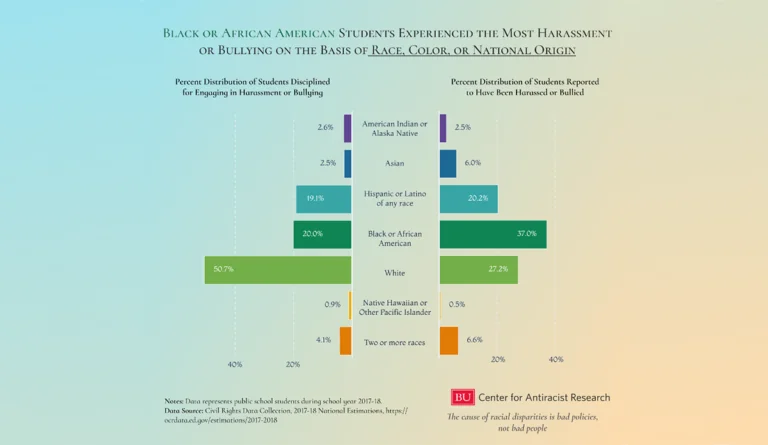Students of Color are Disproportionately Bullied and Harassed at School
Despite making up only 15% of the U.S. K-12 population, 37% of Black students report being bullied at school.

Read Time: 3 minutes
Published:
Sending your child to school for the first time is both an exciting and anxious milestone for any parent. One source of anxiety is the fear that your child might experience bullying or harassment.
In the U.S., 20% of K-12 students are bullied, and race is the leading identity factor for students experiencing bullying. Black students are significantly more likely to be bullied than their White peers.
Bullying may cause physical and mental damage to the victims and leave life-long scars that can hamper children’s ability to have healthy social and professional lives. Bullies, and even bystanders, can also experience harm. Bullies might experience increased risks of academic underperformance, unemployment, and other risky behaviors, including self-harm. Bystanders might have a higher risk of anxiety and depression–a result of the fear of being targeted themselves or the guilt of not intervening. School bullying is a lose-lose situation that should be prevented at all costs.
Data from the Civil Rights Data Collection (CRDC) show the demographics of all bullying incidents between students based on race, skin color, and country of origin reported by public schools during the 2017-2018 academic year. The data documents drastic contrasts between the racial compositions of who bullies and who is bullied.
Students of color were disproportionately overrepresented in the bullied population. Black students make up the largest proportion at 37% despite being only 15.1% of the K-12 student population. On the other hand, White students engaged in 50.7% of the reported race-based bullying and harassment cases, but they comprised 47.3% of all enrolled students.
The discrepancy is probably wider than the data shows, however, as students of color are less likely to report being bullied but are more likely to be disciplined for bullying. Therefore, the percentage of bullied students of color might be higher, while the percentage of bullies who are students of color may be lower. In addition, bullying is increasingly happening through technology, also known as cyberbullying, which may not be recorded at school.
So, what can parents do to prevent bullying at school? It is important to acknowledge racial bullying, promote disclosure, and validate your child’s concerns. Follow the federal guidelines and seek legal assistance if needed since most U.S. states have anti-bullying laws or policies. Also, encourage your children to step up when others are being bullied, since the presence of bystanders who don’t intervene might encourage more bullying. Finally, teaching your children how to properly build self-esteem is crucial, as bullies are oftentimes motivated by the false idea of building self-confidence via bullying.
Databyte via the Boston University Center for Antiracist Research.
Public Health Post is collaborating with researchers at the Center for Antiracist Research Racial Data Tracker to produce a series of articles focused on structural racism and health. This is the fifth article in the series.
The goal of the Racial Data Tracker is to collect, analyze, and publicly share data on racial inequities and disparities with communities and individuals interested in using racial data for research, advocacy, education and policy. The data will be available through downloadable data tables, infographics, and interactive visualizations. The project will publicly launch in Spring 2023.




